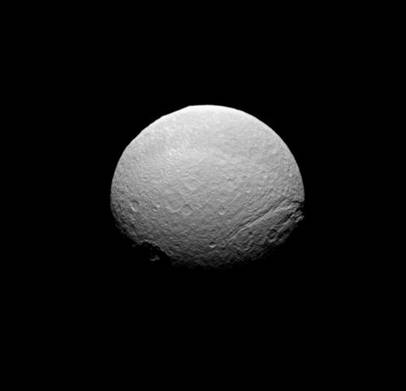10 June 2008

Credit: NASA/JPL/Space Science Institute
NASA recently published a stunning image of Tethys, one of Saturn’s bizarre moons. The image was acquired by the Saturn-bound Cassini spacecraft.
The Cassini spacecraft imaged the southern hemisphere of the scarred face of the icy moon Tethys (1,062 km across). The moon's south pole is at bottom center, just above the terminator, the line between the day and night sides of Tethys.
To the left of the pole is the crater Melanthius, with its complex of central peaks towering upward into sunlight. Ithaca Chasma, one of the largest valleys in the Solar System, is visible on the limb at right. Ithaca Chasma is 100 km wide; 3 to 5 km deep; and extends for about 2,000 km.
Markedly, the smoothness of the limb of Tethys is interrupted at the 11 o'clock position by the rim of the giant impact crater Odysseus. A belt of dark terrain girdles the moon's equator.
The image was taken in green light with the Cassini spacecraft narrow-angle camera on 10 May 2008. The view was acquired at a distance of approximately 477,000 km from Tethys. Image scale is 3 km per pixel.
Tethys orbits Saturn in a circular orbit whose radius is approximately 295,000 km. The orbital period is only 1.9 days.
In Greek mythology, Tethys (a sea goddess) was a sister of Cronus (Saturn) and a wife of Oceanus.
Further Reading
The Cassini-Huygens Mission to Saturn
http://saturn.jpl.nasa.gov/home/index.cfm
Aymen Mohamed Ibrahem
Senior Astronomy Specialist